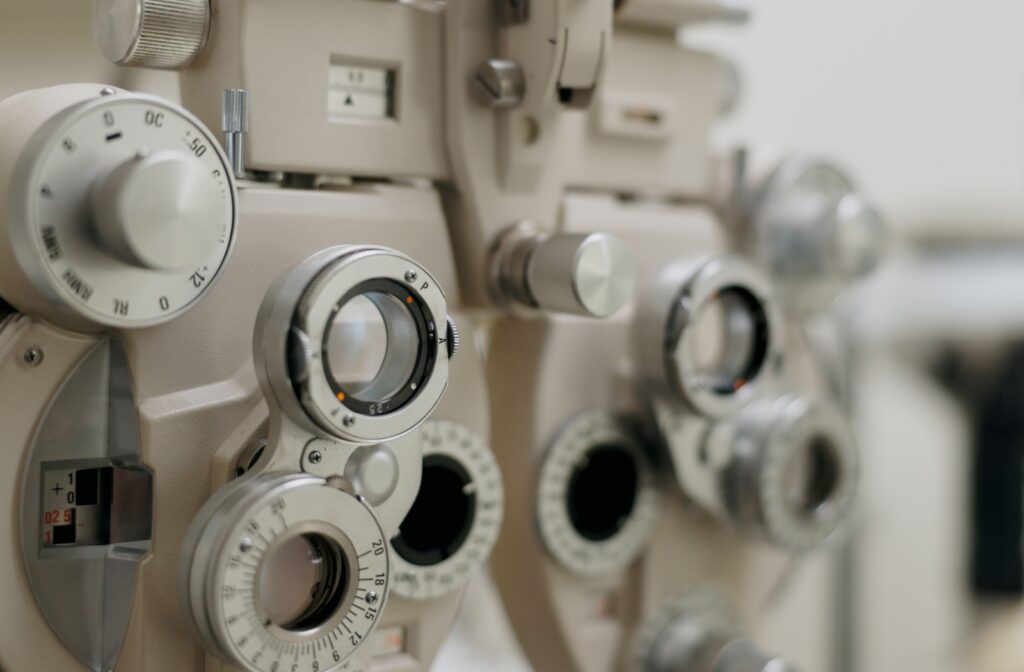You grab your glasses in the morning and notice things still look blurry. Maybe you borrowed a friend’s reading glasses at work, or perhaps you’ve been putting off updating your prescription for months.
Wearing an incorrect prescription typically won’t cause permanent damage to the eyes, but it can lead to significant discomfort and may interfere with proper visual development in children. The symptoms you experience, like headaches, eye strain, and blurred vision, are your body’s way of telling you something isn’t right with your current lenses.
What Happens When You Wear an Incorrect Prescription
When your glasses or contacts don’t match your vision needs, your eyes and brain have to work much harder to create a clear picture. This constant strain is what leads to those uncomfortable physical symptoms. Your visual system is trying to compensate for the error in the lenses.
Effects on Adults
If you’re an adult, your eyes are fully developed. Wearing the wrong prescription is unlikely to cause permanent damage to your vision. However, the constant effort to focus, similar to the effects of digital eye strain, can lead to significant discomfort, affecting your daily activities and productivity.
Effects on Children
A child’s visual system is still growing, so an incorrect prescription is a more serious issue. Their eyes are actively developing pathways to the brain. An inaccurate prescription can hinder this process and may even cause refractive errors like nearsightedness to progress more quickly.
If a child’s glasses don’t fully correct their vision, the eye may elongate in an attempt to focus, which can worsen nearsightedness over time. This makes regular check-ups with an eye doctor especially important for young people.
Signs Your Prescription Might Be Wrong
Getting used to a new pair of glasses can take some time, often a few days or even up to 2 weeks. Your brain needs this period to adjust to a new way of seeing the world. If you still experience discomfort after this adjustment window, your prescription might need another look.
What Eye Strain Feels Like
Eye strain from an incorrect prescription can show up in several ways. You don’t have to experience all of these to know something is off. Pay attention to how you feel, especially after reading or using a computer for extended periods.
- Blurred or double vision
- Persistent headaches
- Soreness in or around your eyes
- Scratchy or burning eyes
- Constant squint
- Trouble with concentration
Can Incorrect Glasses Cause Dizziness and Balance Problems?
Yes, an improper prescription can absolutely interfere with your sense of balance. Your vision plays a huge role in your depth perception and spatial awareness. When your glasses distort what you see, it can confuse your brain’s ability to judge distances and positions.
This confusion can make you feel dizzy, lightheaded, or off-balance. If you already experience conditions like vertigo, the wrong glasses might trigger or worsen your symptoms. A comprehensive eye exam can help determine if your prescription is contributing to these feelings.

Common Myths About Eyeglasses and Vision
Many ideas about eyeglasses and vision health have been passed down over the years. Some of these common beliefs are simply not accurate. Let’s look at a couple of myths and clarify how your eyes and glasses really work together.
Myth 1: Glasses Weaken Your Eyes
This is a persistent but untrue idea. Corrective lenses don’t make your eyes lazy or dependent on them. Instead, they help focus light properly onto your retina, allowing your brain to see a sharp image without the extra work. This actually reduces strain.
Your prescription may change over time due to natural aging or other factors, but this happens whether you wear glasses or not. Eyewear just helps you see clearly and comfortably through these changes. It’s a tool for support, not a crutch that causes weakness.
Myth 2: A Weaker Prescription Strengthens Your Eyes
Some people believe that intentionally wearing a weaker prescription can “exercise” their eyes and make them stronger. In reality, this forces your eyes to constantly strain to overcome the deficit. This added effort doesn’t build strength; it just causes fatigue, headaches, and discomfort. Instead of “exercising” the eyes, a professional may recommend supervised vision therapy to train specific visual skills.
For children, this practice can be particularly unhelpful, as under-correcting their vision could encourage their eyes to change more rapidly. Your eyes work best when they have the support they need. An accurate prescription allows your visual system to function efficiently.
The Importance of a Correct Prescription
Your vision is not static; it changes throughout your life. These changes are a normal process, and keeping up with them is a key part of maintaining your eye health. An up-to-date prescription is more than just a number; it’s a personalized tool for clear, comfortable sight.
Regular eye exams are the best way to make sure your prescription meets your current needs. A comprehensive check-up allows us to not only track your vision but also assess the overall health of your eyes. This proactive approach helps you see your best at every stage of life.
Your vision deserves personalized attention. If you’re experiencing any discomfort or have questions about your prescription, schedule a visit with our Total Vision Rancho Santa Margarita team. We can help you and your family see the world with clarity and comfort.


